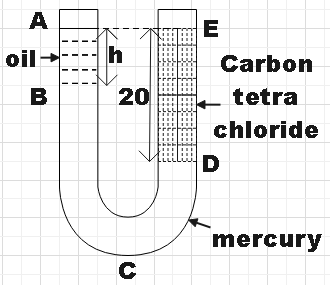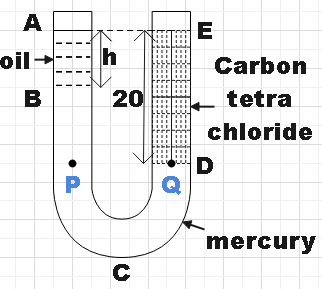
Calculate h in the U-tube shown in the figure. (Density of oil =$0.9gc{{m}^{-3}}$, density of carbon tetrachloride = $1.6gc{{m}^{-3}}$ and density of mercury =$13.6gc{{m}^{-3}}$).


Answer
540.9k+ views
Hint: You could first consider two arbitrary points in the two arms such that they are at the same depth from the mouth of the tube. Now you could apply Pascal’s law to conclude that the pressure at these points will be the same. You could substitute accordingly and then solve the linear equation so formed to arrive at the answer.
Formula used:
Pressure at depth d,
$P=\rho gd$
Complete answer:
In the question we are given a U-tube that is filled with three liquids, namely, Carbon tetrachloride, mercury and oil. In the figure we are given the height at which oil is filled to be h and we are supposed to find this value.
We know from Pascal’s law that the pressures at the points that are at same depths are equal.

So, the pressures at points P and Q are equal. At P we have the sum of the pressures due to the column of oil and that of the column of mercury, that is,
${{P}_{P}}={{\rho }_{o}}gh+{{\rho }_{m}}g\left( 20-h \right)$ …………………………………………… (1)
Now at Q we have the pressure due to the column of carbon tetrachloride above it. That is,
${{P}_{Q}}={{\rho }_{C}}g\left( 20 \right)$ ……………………………………………….. (2)
Equating (1) and (2) we get,
${{\rho }_{o}}gh+{{\rho }_{m}}g\left( 20-h \right)={{\rho }_{C}}g\left( 20 \right)$
Substituting the values,
$\Rightarrow 0.9h+13.6\left( 20-h \right)=1.6\times 20$
$\Rightarrow 12.7h=240$
$\therefore h=18.9cm$
Therefore, we found the height of the oil column in the given U-tube to 18.9cm.
Note:
In case if you’re wondering how we arrived at the unit being centimeters, then, you could look at the given values of the densities in the question where all three of them are given in cgs units. Hence, we got the height in centimeters. While solving such questions you have to choose the points in the two arms such that it is more convenient.
Formula used:
Pressure at depth d,
$P=\rho gd$
Complete answer:
In the question we are given a U-tube that is filled with three liquids, namely, Carbon tetrachloride, mercury and oil. In the figure we are given the height at which oil is filled to be h and we are supposed to find this value.
We know from Pascal’s law that the pressures at the points that are at same depths are equal.

So, the pressures at points P and Q are equal. At P we have the sum of the pressures due to the column of oil and that of the column of mercury, that is,
${{P}_{P}}={{\rho }_{o}}gh+{{\rho }_{m}}g\left( 20-h \right)$ …………………………………………… (1)
Now at Q we have the pressure due to the column of carbon tetrachloride above it. That is,
${{P}_{Q}}={{\rho }_{C}}g\left( 20 \right)$ ……………………………………………….. (2)
Equating (1) and (2) we get,
${{\rho }_{o}}gh+{{\rho }_{m}}g\left( 20-h \right)={{\rho }_{C}}g\left( 20 \right)$
Substituting the values,
$\Rightarrow 0.9h+13.6\left( 20-h \right)=1.6\times 20$
$\Rightarrow 12.7h=240$
$\therefore h=18.9cm$
Therefore, we found the height of the oil column in the given U-tube to 18.9cm.
Note:
In case if you’re wondering how we arrived at the unit being centimeters, then, you could look at the given values of the densities in the question where all three of them are given in cgs units. Hence, we got the height in centimeters. While solving such questions you have to choose the points in the two arms such that it is more convenient.
Recently Updated Pages
Master Class 8 Maths: Engaging Questions & Answers for Success

Class 8 Question and Answer - Your Ultimate Solutions Guide

Master Class 7 Maths: Engaging Questions & Answers for Success

Class 7 Question and Answer - Your Ultimate Solutions Guide

Master Class 6 Maths: Engaging Questions & Answers for Success

Class 6 Question and Answer - Your Ultimate Solutions Guide

Trending doubts
What is meant by exothermic and endothermic reactions class 11 chemistry CBSE

Which animal has three hearts class 11 biology CBSE

10 examples of friction in our daily life

One Metric ton is equal to kg A 10000 B 1000 C 100 class 11 physics CBSE

1 Quintal is equal to a 110 kg b 10 kg c 100kg d 1000 class 11 physics CBSE

Difference Between Prokaryotic Cells and Eukaryotic Cells




